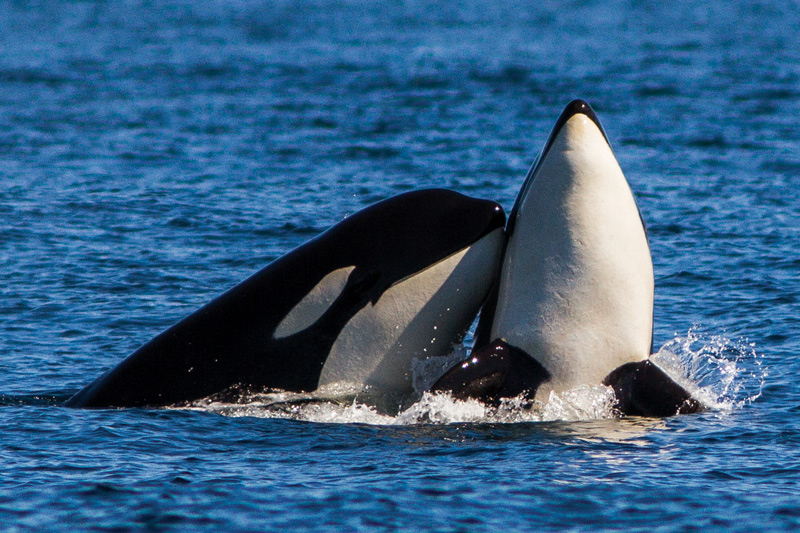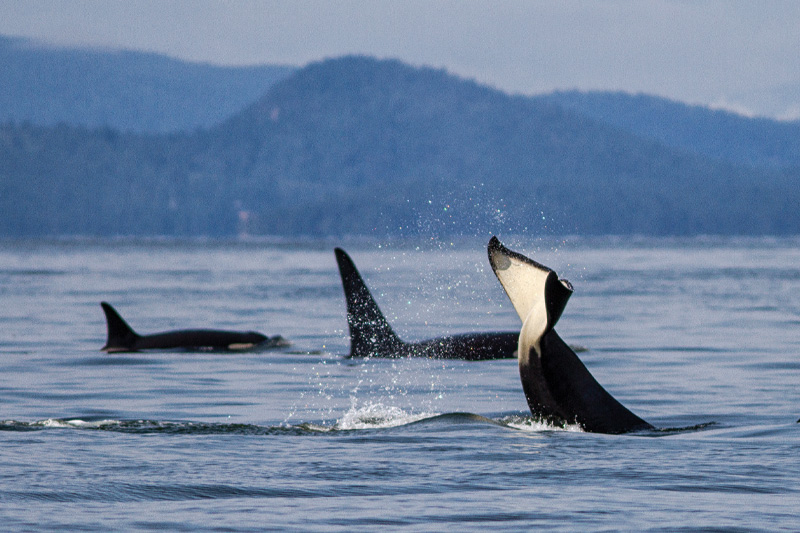
My husband and I grew up on opposite sides of the Pacific Ocean – I grew up in Oregon, whereas he was born and raised in New Zealand. Although we both speak English and generally have the same tastes and habits, every now and then a cultural difference will unexpectedly surface, sometimes accompanied by delightful interest, other times by frustration. We don’t tend to think that animals have these same regional idiosyncrasies, but one organism that truly mirrors humans’ social structures are orcas, or killer whales.
Orcas are found all over the world. There are populations in the North Atlantic, the Arctic, the Southern Ocean, the North Pacific, and the South Pacific. Each region has their own food preferences, a distinct way of hunting for food, and a unique dialect. These regional populations of orcas are known as ecotypes. Some experts argue each ecotype is a separate species and that we are witnessing the origin of speciation. However, for the purposes of this article, we will refer to the different groups of orcas around the world as ecotypes.
There are several ecotypes in the Southern Hemisphere, while here in the Northern Hemisphere we can claim another five ecotypes with the Type 1 and Type 2 in the eastern North Atlantic. In the North Pacific, we have the offshore killer whale, the Bigg’s killer whale (also known as a transient killer whale), and perhaps the most well-known and loved by the public here in the Pacific Northwest, the resident killer whales. Each ecotype has a preferred regional cuisine, and they can differ greatly from other ecotypes even if their territories overlap. Perhaps one of the most well-known distinctions is between the resident orcas, who have a strong preference for Chinook salmon, and transient orcas, who eat marine mammals. In New Zealand, the most coveted dish for orcas is stingray.
Along with these different tastes in foods comes different hunting strategies. New Zealand orcas carefully lift stingrays off the seafloor by their tails. Whales in the Antarctic use a sophisticated level of coordination by swimming in formation under a slab of ice to create a wave, causing unsuspecting seals or penguins on top to be washed into the water. The orcas off the coast of Patagonia may have the most dramatic hunting strategy. They purposefully beach themselves to attack young sea lions, dragging them back in to the depths.

Much like how humans teach their children correct ways to hunt, farm, or gather food, orcas teach their young their traditional hunting behaviors. There are many stories of adult whales “playing” with a young seal, allowing the calves to chase it around, ultimately to the seal’s demise. These cat-and-mouse sessions teach calves how to hunt. Some of this teaching would be demonstrative, but orcas are also highly vocal, and so may pass on these behaviors through vocal communication akin to an oral history or traditional knowledge. Again, like people, each ecotype has unique sounds and vocal patterns that they employ, which researchers even refer to as dialects. Not only can a biologist identify the ecotype of an orca by its physical appearance, but also by listening to their calls. These different dialects can be as unique from each other as different languages, or as colloquial as different accents.
Language reinforces community relationships, and these strong familial bonds are perhaps the most recognizable of all to us. Southern resident orcas of the Pacific Northwest will travel in large pods, which can be broken down into matrilineal family units with brothers, sisters, aunts, uncles, grandfathers, and most significantly grandmothers that travel, hunt, and survive together. The grandmothers play an important role as strong leaders for their families, and this may be due to a physiological process – menopause – that has cultural and behavioral implications
These older, post-menopausal females are the matriarchs of their family units (interestingly, menopause is very rare in the natural world – killer whales and short-finned pilot whales are the only two species, besides humans, in which it has been confirmed in wild individuals). For example, Granny, a member of J-pod, was the matriarch of her “village” for as long as researchers had been tracking J-pod, close to 40 years. Ivan Reiff, the owner and operator of Western Prince Whale and Wildlife Tours based in Friday Harbor in the San Juan Islands, says they would often see Granny with her son, Ruffles, swimming ahead of the pod, leading the way. Granny passed away sometime in the beginning of this year, and this hole in leadership may leave the pod at risk. Perhaps a new matriarch will rise to the challenge to help guide and weather her family through future storms, both literal and metaphorical.
Some of these aspects of orca culture are so strong, however, that it could be their downfall. Southern residents’ preference for Chinook and chum salmon is so strong that it appears that they do not explore alternative food sources when salmon populations are low. On the other hand, orcas demonstrate a high level of shrewdness, much to the chagrin of commercial fishermen. Some groups of orcas around the world pick fish off longlines, having learned to wait for a meal to come to them rather than looking for a meal themselves. In other ways, they show flexibility, ingenuity, and adaptability to their changing environment. There are some changes that orcas are less adaptable to, and while globally the species is doing well, localized ecotypes have suffered from human activity, such as pollution, overfishing, intrusive boat interactions, and, historically, the marine mammal park trade. If it is true that these ecotypes of orcas are significantly genetically distinct, then it could be that we are not only losing a local population, but perhaps a species.
As we discuss how to conserve orca populations, we need to consider both environmental and cultural aspects. As discussions of orca conservation takes place, not only can we think in the typical ecological approach, but we can also think of it in terms of a loss of culture – a loss of oral history, hunting practices, traditional diets, and collective memories. Their traditions may represent personal importance to them, a sense of identity, and history that is hard to articulate to outsiders, yet irreplaceable.
This sense of belonging was something apparent to me when I would encounter Americans, especially from the Pacific Northwest, when I lived in New Zealand and Australia with my husband for a few years. There was always that unspoken feeling of mutual understanding, and most importantly, I didn’t feel the need to explain myself. I wonder if a J-pod orca would feel the need to explain themselves if they were to somehow meet a killer whale in New Zealand. Would they find common interests? Would they misunderstand each other? Would they enjoy each other’s food? These experiences are part of the frustration and intrinsic value of diversity. We should ensure the future of the orcas not only for the sake of their environment, but for the sake of their irreplaceable cultural value to the natural world.
Photos by Ivan Reiff/westernprince.com


